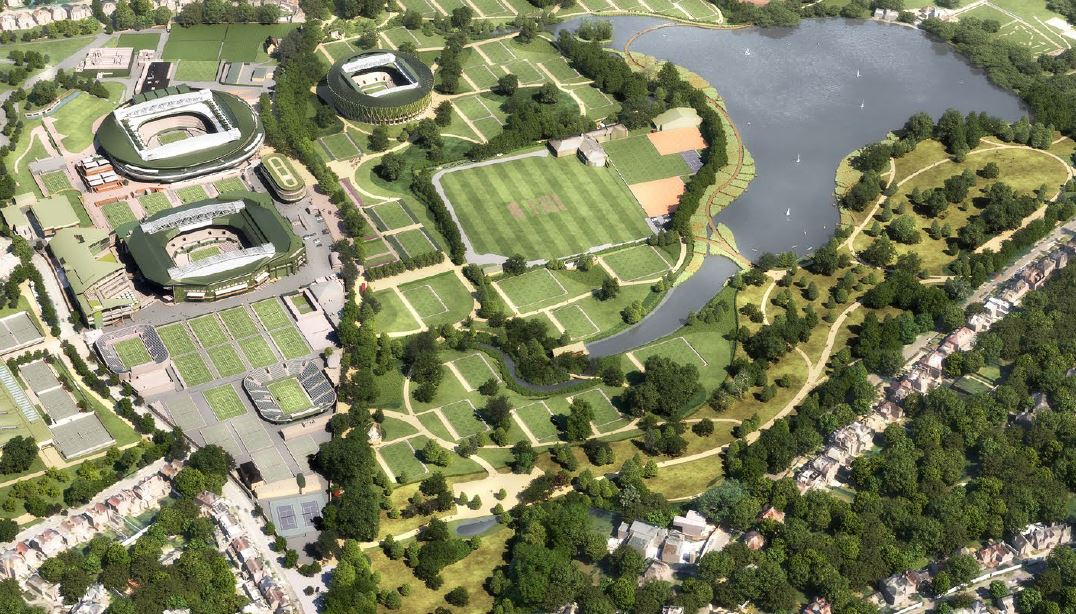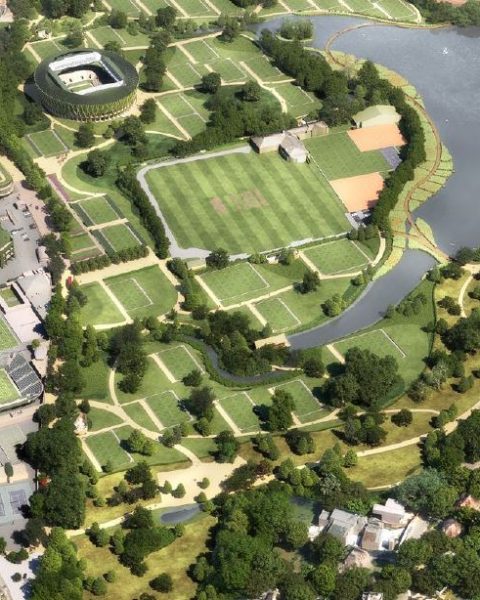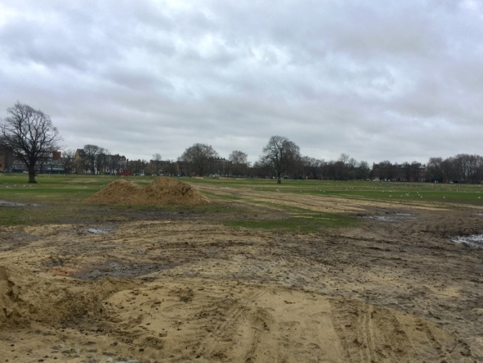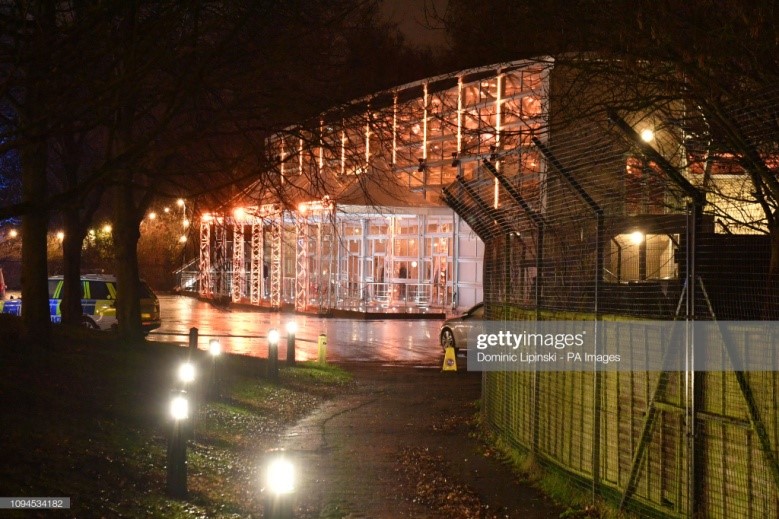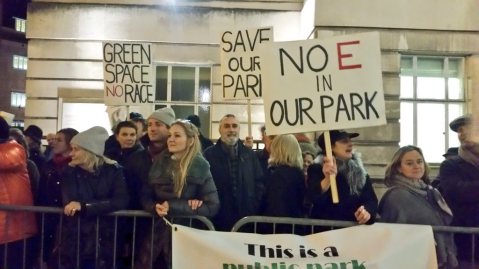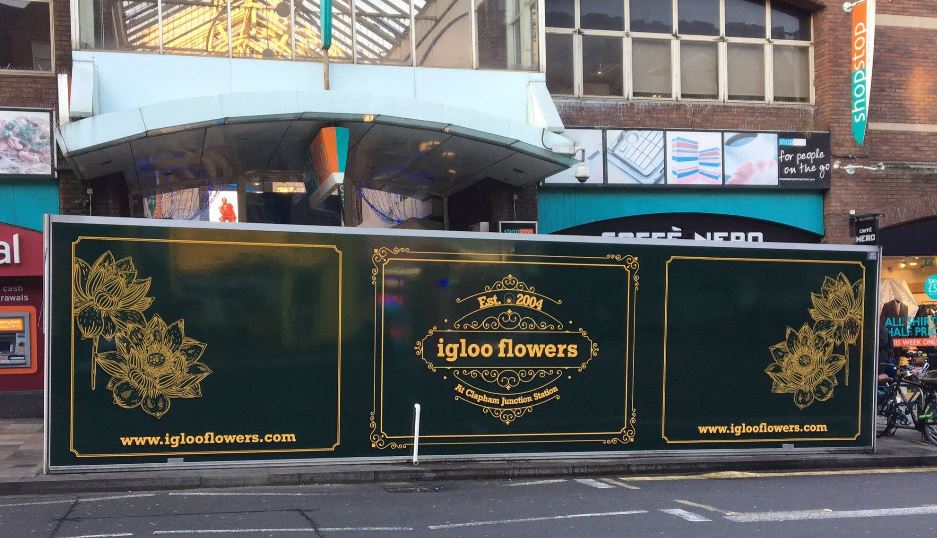The proposals to build 39 new courts on Wimbledon Park put forward by the All England Lawn Tennis Club (AELTC) has moved a step closer to full approval after officers from the Greater London Authority recommended that the project should be granted.
The plans, initially presented in 2021, aim to expand across Church Road to build an 8,000-seat stadium (104 metre wide and 28 m high), an additional 38 grass courts, 10 other buildings including a 30,000 sq ft maintenance hub, and 9kms of roads and paths at the former location of the Wimbledon Park Golf Course. The Wimbledon Tennis site would almost triple in size.
This development would enable Wimbledon to hold its qualifying tournaments on the grand slam site (SW19 location) instead of their present location a few miles away in Roehampton. The AELTC’s outlined plans, set to be finalized by 2030, also involve creating 23 acres of parkland partly accessible to the public.
About 2,000 trees are anticipated to be cleared from roughly 70% of Wimbledon Park, which corresponds to 75 acres of Metropolitan Open Land (MOL), Grade II* Heritage parkland, to allow space for the Tennis Club extension (all the areas highlighted in pink in the drawing below).
Merton Council approved the application on Thursday 26 October after an extended debate where 6 Labour councillors voted in favour while 4 others (including one Labour, the 2 Libdems and the single Conservative councillors) voted against. The decision was based on the benefits they think it would generate. In the own words of Merton’s officers reports, development would be “inappropriate” and cause “physical harm” to the Metropolitan Open Land, but all of that could be outweighed by the “very substantial public benefits” of the proposal.
A few weeks later, Wandsworth Planning committee had to consider the application too, as the land in question straddles the two boroughs. Councillors took the opposite view and refused planning permission, following the recommendation of Wandsworth’s officers who disagreed with their colleagues from Merton.
- Read more about the controversy and debates in Merton and Wandsworth councils here: Wandsworth Council rejects controversial expansion plan for Wimbledon Tennis Club
Now, planning officers at the GLA have released their 221-page report stating that the project complied with most relevant planning policies and there were “no material considerations that are considered to justify the refusal of consent“.
While brushing aside the legal challenge, the environmental concerns and years of disruption to the park, they highlighted that it would bring benefits in the form of “40 year-round jobs and 256 Championships jobs”.
The final verdict will happen on 27 September, during a full planning hearing at City Hall. During the GLA meeting, all speakers who wish to oppose the scheme have only a total of 15 minutes to present their arguments.
The decision will be taken by Jules Pipe, the deputy mayor of London, as the mayor, Sadiq Khan, excused himself from the process having publicly voiced his support for the plans in 2021. During a video interview with The Wimbledon Channel in July 2021, he said:
“We have been working really closely with Wimbledon and I give them credit for the collegiate way they have been working with the local community, with the local councils, with us and City Hall, to make sure we can add value to the world’s premier tennis tournament. I think this development will future proof Wimbledon for years to come. It will be amazing in years to come to see the qualifying events taking place here in Wimbledon.”
Whatever is the decision, the battle does not seem over
AELTC expects City Hall to approve the plan, with the Guardian saying: “It appears to be game, set and match for the AELTC in its lengthy battle“.
While not unexpected knowing the London mayor’s support, campaigners against the Wimbledon tennis club’s plans are disappointed and will certainly attend in force at the GLA meeting on Friday 27th. Jonathan Morrish of Save Wimbledon Park commented:
“The general direction of the report is not what we wanted and the admission of loss of open space and harm to protected MOL is deeply distressing to local residents whose views haven’t been taken into consideration.”
With the plan to fell 304 mature trees and replace them by 1500 whips and saplings, campaigners say that it takes 500 whips 10 years to replace only one mature tree. Therefore, the AELTC effort will only replace three trees. They also highlight that with climate change, it is unknown how many new trees will last, and if even grass courts will be viable in the long term. They add that “the application would be devastating for the environment, wildlife, plant life and air quality“.
Paul Kohler, the MP for Wimbledon, expressed his regret of the officers’ decision. He urged the Deputy Mayor to reject the recommendation. He said that failure to do so would be a “flagrant disregard of the AELTC’s historic promises not to build on the land“, and will be “showing complete contempt to the people of Wimbledon“.
My statement regarding the forthcoming GLA hearing on the AELTC’s plans regarding Wimbledon Park.
Supported by @HinaBokhariLD, @Gareth_Roberts_ , @AJ_Fairclough, @sammacart, @jil_hall & @tonyreiss_uk pic.twitter.com/jJD31NOGu8
— Paul Kohler🔶MP for Wimbledon (@PaulKohlerSW19) September 20, 2024
Save Wimbledon Park campaign is organising a public meeting to discuss the GLA Planning Officers Report and the next move. Meeting will happen at St. Barnabas Church, 146 Lavenham Road, Southfields, London SW18 5EP on Monday September 23rd from 1930 – 2130 .
They are also planning a demonstration outside City Hall on Friday September 27th, 9am for the GLA Hearing (starts 10am, doors open 8:30am).
Whatever is the outcome at the end of September, the battle seems far from over, as there are legal issues that are still undecided.
Last year, while Merton’s Labour councillors approved the plans, in a very strange and unprecedented move, Councillor Ross Garrod, the Labour leader of the Merton Council, seemed to question the legality of the decision of his own councillors. In his letter, Councillor Garrod wrote:
“The Wimbledon Park Golf Course is subject to restrictive covenants established in the 1993 transfer to All England Lawn Tennis Ground (AELTG). These restrictive covenants include requirements for the owner to use the land only for leisure and recreation or as an open space and places restrictions on the erection of buildings. The development for which planning consent has been granted cannot commence without addressing the restrictive covenants in the 1993 transfer.
I would be grateful if you could advise how you intend to implement the planning consent, if granted, without breaching the restrictive covenants.”
When Merton Council sold the freehold to AELTC for £5.2 million in 1993, the tennis club entered into a legal covenant that prohibited any use of the land aside from leisure, recreation, or as an open space, prohibiting construction on the Grade II* listed parkland.
During a special meeting organised by Merton Council on 15 November, it was explained that there are 2 ways to circumvent the legal requirement: Either ask the council to release or modify the covenant, as the council is the party with the benefit of the covenant in its capacity as landowner of the adjoining Wimbledon Park; and/or seek a discharge by making an application to the Upper Tribunal (Lands Chamber).
Although AELTC has never explained how they intend to proceed, they have always declared that they do not see any real issue with the convenant.
A precedent with a decision for the use of Wandsworth Common
In July 2017, a High Court judge ruled that Wandsworth Council acted unlawfully in offering a lease for the use of Neal’s Lodge as a private fee-paying nursery. Such use would effectively restrict its availability to all but the more privileged local residents.
Mrs. Justice Lang said that clubs or golf courses can’t stop the public from using them, unlike giving a lease for a private nursery which would restrict access to the few children and families registered with the facility. The judge said:
“The grant of a lease to the [nursery] for 15 years will prevent any public use of the premises for a significant period of time. In my judgement […] the nursery does not provide facilities for public recreation. […]”.
The decision was based on the fact that the Council does not have powers under the 1967 Greater London Parks and Open Spaces Provisional Order (“the Long Act”).
However, at the time of the decision to approve the proposal, the Planning Applications Committee was advised that the restrictions in the Long Act were not a planning consideration. It draws similarity to Merton’s committee and the Mayor being advised by officers that they should ignore the covenant as – in their views – this is not a material consideration for the planning decision.
Wandsworth Council appealed the decision but subsequently lost as the initial decision to declare the planning application unlawful was confirmed.


